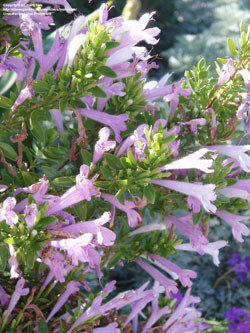A member of the Lamiaceae or mint family, Mexican oregano has grown in my Zone 8b garden for about 20 years. During that time, it has proven itself to be a long-lived, high performing perennial.
In my garden, cold weather has never killed Mexican oregano to the ground. Comments on Dave’s Garden Plant Files indicate that it is hardy in Zone 7b and probably beyond that. In colder areas, Mexican oregano dies down during the winter. It may be root hardy a bit farther north than zone 7b. In areas where it dies to the ground but remains root hardy, new stems arise each spring. Since bloom is on new wood, a crop of flowers can be expected every year regardless of whether it is evergreen, semi-evergreen, or only root hardy.
I believed the correct name was
Poliomintha longiflora until recent research indicated other options. According to GRIN, the correct name is
P. bustamenta. Other references call it
P. maderensis. I won’t argue, but my most trusted reference is the GRIN website, so I’ll go with
P. bustamenta. Common names encountered in my research are: rosemary mint, lavender spice, Mexican oregano, and Madrean rosemary.
By whichever scientific name or common name it is called, this plant has long been a favorite in my garden. I ordered it from a mail order source many years ago. It has been in the place where I planted it ever since; never spreading, never reseeding, but blooming year after year after year and proving itself to be an attractive and dependable perennial.
Diminutive leaves are one fourth to one half an inch long and emit an oregano-like fragrance when crushed or brushed against. Each flower has five petals and forms a funnel-shaped tube about one and one-half inches long. While this may sound like a small flower not capable of putting on much of a show, when the plant is in full bloom, hundreds hang on the branches and make quite an impact. Flower color ranges from a very light pink to deep lavender, starting out light pink and darkening as they mature.
I have never seen seeds on my plant and it has never spread about. Perhaps a suitable pollinator is not present, or maybe flowers on my plant are self incompatible. Although the clump is now large enough to dig and divide, I have never felt the need to do this because the clump is mannerly and very slow-spreading.
Growth and habit of the plant depend on where it is grown. In warm desert regions where it remains evergreen, it tends to be a woody shrub. In cooler climates where it gets killed to the ground in winter, it performs more as an herbaceous perennial or subshrub. Pruning back to the base each winter can force more herbaceous growth. Plants grow three to four feet tall and wide, and stems tend to arch over as the flowers develop and weigh the branches down.

Mexican Oregano is best in full sun, but filtered shade is acceptable, especially in very hot, sunny areas. Soil must be very well drained, as the stems will rot in consistently wet soil. Plants are denser and more floriferous in full sun.
Most references indicate that the foliage is edible, but others recommend caution since at least one species of Poliomintha contains toxic compounds. If you choose to make culinary use of the leaves, expect it to taste a bit stronger than oregano. Reader comment is invited regarding the use of Mexican oregano in cooking.
Perhaps Mexican oregano is right for your garden. It is deer resistant and heat and drought tolerant. Hummingbirds and other pollinators are attracted to the flowers. If you live in a hot, arid region, you will find it particularly well adapted. However, it is a high performer in the sandy soil of my hot, humid part of the world. Pests have never bothered it. Its main limitations seem to be a lack of hardiness beyond Zone 8a or 7b and its intolerance of soggy, wet soil. Beyond that, it would seem worthwhile to grow Mexican oregano as an annual. With all these attributes, one quickly recognizes that Mexican oregano is more than just another pretty face in the garden. It is a long-lived, beautiful addition to the herb garden or perennial border.






